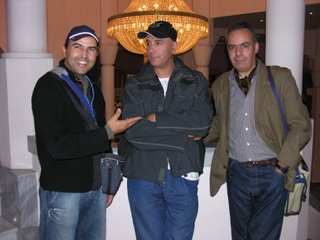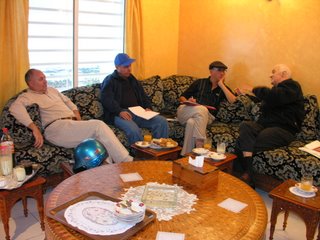




 photographed By Safi El Khammar
photographed By Safi El Khammar photographed By Safi El Khammar
photographed By Safi El KhammarBrahim Sayah
Brahim Sayah, reflecting memory and image of a nation
Designed by a beautiful cinematic signs , Brahim Sayah’s visit card was a wonder and magical tool that any cinemagoer would love to have and marvell at.Ever since 1948,this giant man of cinema had worked in movies either in his native land Morocco, or his inspiring second country, France.
In his elegant manner of debating and talking , Brahim Sayah was a didactic and practical man .His soft and spiritual face reminds me of a great Tarkovskian actor , Erland Josephson in ‘Sacrifice’ .He was certainly a man of rythm and had a sense of great vision in montage .This echoed his golden age of dubbing stage great French and Indian movies for the Arab world especially Grand Maghreb audiences .
The dubbing was expicilty done into arabic slang .That time American and Italian movies were prevailing Grand Maghreb theatres . People would find it difficult to go to cinemas because of street repressions by the colonists . Brahim Sayah volontarily exiled to France where he met brilliant technicians of editing and dubbing whose influence played a major role to make him become a master in his work. He was a remarking man who had great impact on Moroccan memory. He knew what he proudly did in his past, either as a dubbing rythmographic man or simply as a dialog writer and looping cutter . He kept siting with intense care and tenderness that he was a man of Doublage , a common french word that even the most prolific sound designer in America , Walter Murch would use .
In his cultural filmic background , he knew classical french cinema ,Nouvelle vague and Sergei Eisenstein movie ‘Bronenosets Potyomkin’*and mainly ‘ the conversation ‘ a unique movie about sound by Francis Ford coppola.
Brahim would see this movie too many times because it gave him power and feeling of the sound « It's a film that has an intensely single point of view. Everything in the film is seen or experienced by Harry Caul [Gene Hackman]. You know he's a soundman, and the film never lets you off the hook, so after a while, you just begin to accept the fact that you, too, are a soundman and you, too, should consider that sound is important. » .
One of his inspiring french movie he firstly worked with was ‘ Le Bossu ‘directed by Jean Delannoy in 1944. It was dubbed stage into classical arabic with excellent arab actors and actresses like Jamil Ratib, Mona wassif , Hassan Baba, Hanae and Mohammed Kabssi. Amazingly the mood of working was artistically fervent between arabs and french .Most of his technicians were french such as Delparthe,Transpurse and Jacques Orth. Because this technical experience was a marvellous success , Brahim with his french team worked in other french movies ‘ l’homme qui rétrécit ‘ directed by Jack Arnold and later on ‘ children of the sun ‘ directed by Jacques Sévérac.
Francorex films , a production compagny admired Sayah’s artistic achievements, proposed to him an Indian movie called ‘ Saki and the lamp of Aladin’ . Although Indian movies were and still so long in metrage about 3000 and 4000 metres, Brahim Sayah was impressed by this genre of cinema, full of beautiful colours ,romantic scenes and godlike lyrics sung by Lata Mangeshkar, Kishore and Mukesh . It especially reminded him of his dear country,Morocco . The Grand Maghreb actors and actresses would compete so hard and so well to have the leading roles . Hamido Ben Masoud and Ahmed Ziani would dub stage great indian actors like Filip Kumar and Shammi Kapoor , others like Haj Omar, Mohiedine Bostarji from Algeria and Ali Ben Ayad , ex- director of Tunis Theatre would dub stage other heroic roles too . Humor and exquisite jokes would be inserted into cinematic dialogs by Taeb Saddiki , a Moroccan dramaturge who proudly honored the era when he worked with Brahim Sayah. Gaumont and Pathé kept having an eye on Brahim Sayah ,and In fact, they proposed him other great projects like ‘ FanFan La Tulipe ‘ starring Gerard Philip, ‘A toi de jouer callagan ‘ Ces Dames préférent le Mambo’ and ‘ Ulysse’ starring Kirk Douglass . These projects were dubbed stage by the master with the help of actors and students namely Nour-eddine Ayouch who superheads now a production house in Morocco. These films were distributed in the middle east and north of Africa .
Indian cinema had a tremendous influence on Brahim Sayah .His double culture and exquiste intellect of his personality illuminated his mind and character to work on Hindi movies such as ‘ Mother India ’ directed by Mahboob and ‘ Dosti ’. In 1950, Telma the compagny that installed the first national television in Morocco signed with him a contract to dubb stage Hindi movies . The master called Rabat and casablanca actors and actresses inluding the ones who were with him in France . Mustapha Mounir, Habiba El Madkouri excellently performed with precise diction and tones roles of Nargis and Amitabh Bachchan. Unforgetable Hindi movies dubbed stage into Moroccan slang are still in the memory of cinemagoers and just recently on ‘ Thursday cinema ‘ televised program in the first channel were diffused . They were still loved and too many Moroccans still learnt by heart these movies songs mentioning ‘ Al Hariboun Min Jahannam ‘ Emir Ahmed ‘ and ‘ Mangala ’.
TIME ERA
Actors and Actresses
France-Morocco.
1952 - 1963
Mohammed Kabssi –Taeb Saddiki
Hamido Ben Masoud Ahmed Ziani
Mohiedine Bostarji Ali Ben Ayad Jamil Ratib Mona wassif Hassan Baba– Students in France –Nour-eddine Ayouch…
1963 - 1974
Studio Swissi-Morocco
Rabat artists : Hamido.Larbi Doughmi, Abdel razzak Hakam, Habiba al Madkouri, Hassan Joundi Adessamad Dinia Aziz Mawhoub
Casablanca Artists :Zaki El Howari Wafaa El Harraoui Mohammaed Said Afifi Hassan Skalli Mhammed El Habachi Omar chanbouth khadija assad , Taeb Saddiki.. ;
1974 - 1975/76
Rabat artists : Hamido.Larbi
Doughmi, Abdel razzak Hakam, Habiba al Madkouri, Hassan Joundi Hamadi Tounessi,Latifa Alaoui, Haj Fannan ;Mohammes Karrat ;
Casablanca Artists :Hassan Skalli and his wife , khadija assad , Taeb Saddiki…
TECHNIQUES OF BRAHIM SAYA
How Brahim Sayah was inspired to dubb movies remained a mystical fact.
Indeed, Brahim as a proud man in his country , he marched the Mohamed the fiveth avenue one evening in the late of the fiveties, and then he decided to watch an American film at a movie theatre called EL Colisé .Unfortunatly this theatre became a coffee-shop now. when the film finished , he just asked himself why he could not translate foreign movies into Arabic so that all kind of people would taste the magic of cinema.And that was it .
His theory to work on dubbing was interestingly professional . In the auditorium of the Swissi studio , he would never start to dubb quickly . Taking time to read and reread the movie , was a technical skill so that to achieve the best . In fact, Brahim watched and listened to movies very carfully . He intended to know first the ryhtm, then the pace and at last the tone of the drama . His ears would have then interesting vibrations and only then the master began to dub stage .Brahim stood vey long times in front of mirrors so as to repeat lines . He observed very carefully his lips and his tonic accent . Nowadays , in big post- productions , they use technical terms like ADR, Pitch, SFX and so on .The task was heavy but Brahim Sayah insisted passionatly to do and redo the translation from the language of text into the new language of image and time.Any dubber in the world would be amazed about Brahim ‘s techniques to finish his montage. Sayah divided his filmic sequences into loops in order to work easily. Another technique of Brahim was to use a rythmographic theory .That means, he projected transparent cinematic loops marked by a black line so that it could be easily read for the actor to say his lines .The image and the written word were a hell of a task for him though he was helped by his friends and artists .
In this context Walter Murch states « There's a different weight that a moment (of picture and sound) carries in film, compared to the same moment conveyed by the written word. Everything in film is specific: this person with this colour hair, saying these lines in this way, dressed in these clothes, lit by this light slanting at this angle, with these sounds in the background, etc. These details are always on screen. Every time you see a certain character, you are reminded of his haircut, his gait, the colour of his eyes. A novelist need mention eye colour only once. The mass of all those details, and therefore the amount of processing that your brain is obliged to do, gives a heft to film that text, which is suggestive and allusive, does not command. So you can often "take corners" in text - make sudden leaps and transitions - at speeds that would wreck the film. On the other hand, sometimes the opposite is true: The old saw that "a picture is worth a thousand words" is quite valid under the right circumstances. »
allal el alaoui
razak
safi el khammar


